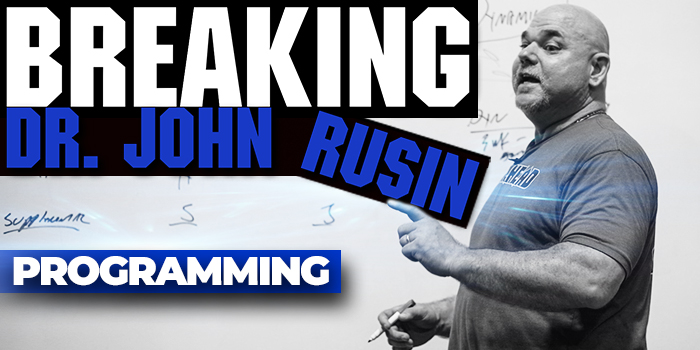
Dr. John Rusin has been working closely with Dave Tate to flip the script on the Fixing Dave Tate Series that kicked off earlier this year. In this twist on the original series, it is now Tate who is coaching Rusin in an effort to accelerate his progress on the three main accessory lifts. Together, they broke down his technique with regard to the squat, bench press, and deadlift in a series of one-on-one coaching sessions that revealed key areas for improvement.
When it came to the squat, Tate and Rusin talked proper body positioning, including rooted feet and keeping the chest and sternum up during the movement. They also discussed the importance of breathing (first in through the nose, then through the mouth) to brace the body and stabilize the midsection for extended time under tension. With Rusin’s bench press, they worked to isolate his lats in an effort to increase stability at the top of the movement and improve his static strength – this was, ultimately, Rusin’s “sticking point”. Tate also encouraged Rusin to let the weight “settle into him” like a powerlifter, thereby assisting with the transfer of force. Finally, during their deadlift session, they reinforced proper shoulder positioning: in line with or behind the bar at all times. They also talked variations of the deadlift and different accessory exercises (i.e. glute-ham raises, hanging leg-raises, etc.) to support the movement.
In this video clip, Tate and Rusin compile these learnings to develop a comprehensive training program. Together, they discuss how to adjust the workouts to best suit Rusin’s development of the “big three” lifts, planning around his traveling schedule as needed. When their whiteboard exercise is done, Rusin is left with a plan to execute.
Tate’s Initial Programming
Tate starts out by acknowledging that before getting into training, Rusin should ensure that he continues to do the warm-up and primer exercises that he has established. Then, when it comes to the max effort movements (for squat and bench days), Rusin should select 5-6 movements that he can rotate through for one week. This means that there are no double-week rotations, such that the movement is constantly changing. Tate refrains from actually noting what these specific movements are, because it will likely differ for each individual based on what equipment they have in their gyms. Nonetheless, the goal is to try and achieve some sort of dynamic correspondence.
With the dynamic work, Tate notes that the squat should be done with a straight bar in a three-week wave, with Rusin avoiding pushing it to be too heavy. This means weight at 40% for week one (10 sets of 2), 50% for week two (12 sets of 2), and 60% for week three (15 sets of 2). Tate emphasizes that volume is what matters here as opposed to workload, helping Rusin to dial in on the technique. When it comes to dynamic work on the bench, Tate recommends a three-week wave again, with weight at 40-60% with a chain only (instead of a band). The goal is to focus on pushing all the way through, especially given Rusin’s explosive training style.
The biggest change for Rusin comes with the supplemental movements to support training for the lifts themselves. For the dynamic squat, it will be a relatively technical day, with speed-pulls, conventional pulls, and singles in a three-week wave (5, 10, and then 15 singles). Supplemental work for the max effort squat will primarily be glute-ham raises, while supplemental work for the max effort bench will be chaos training twice per week. This is similar to the exercises that Rusin did with the Bamboo bar, holding for 3-5 minutes (or, as Tate prefers, one DMX song).
Rusin’s Adjustments
As Tate wraps up the sketch of his initial programming, he hands the whiteboard marker over to Rusin to make any tweaks that he sees as necessary. Rusin confirms the max effort outline for the squat, adding that he’s been doing this every other week, alternating with hip-hinge variations (i.e. trap bar, rack-pull, hybrid-pulls, etc.). He also notes that the first supplemental exercise translates to the primary deadlift strength.
With regard to the max effort bench work, Rusin acknowledges that he typically does one week flat, and then the next couple weeks as an angled press (incline, decline, floor press, flat press). Tate recommends that Rusin avoid floor-pressing, but that he keep the slight incline and decline work. His reasoning is that the goal is to tie these movements into leg drive, which floor pressing takes away by the nature of the position. Furthermore, Tate notes that it could be beneficial to make the second movement still a barbell, particularly if it’s a JM Press. Again, they emphasize the importance of not racking the weight, but rather holding the pull for a second at the top to let the weight “settle”.
Finally, Rusin discusses dynamic work for the squat and the bench. For the most part, his dynamic squat work is going to remain the same, simply shifting from two-week to three-week waves. With regard to the dynamic bench, Tate encourages Rusin to use a three-chain approach as opposed to two. This helps to create a heavier top and prevents the chains from flying up off of the ground, which can happen at times given Rusin’s explosive training style.
Lower Body and Core
A favorite training element of Rusin’s is single-leg work. Not only is he good at it, but he admits that it also provides him with a massive training effect – from his glutes, to his adductors and quads. Tate acknowledges that Rusin can incorporate single-leg work wherever he sees fit into his programming. Nonetheless, he should keep in mind that it doesn’t necessarily make his squat, bench, and deadlift stronger. The same is not true for everyone, however, given that training programming (and results) are always individualized.
As the discussion moves on to core, Rusin asks Tate how he can go about building “core hypertrophy”, as he puts it. As Tate explains it, the reality is that the core will strengthen naturally as Rusin is able to support more and more weight on his back. With heavier loads on the back, the body will adapt with a stronger core to accommodate the weight and protect the spine. Although Rusin can add heavy ab work to his routine, it’s not entirely necessary because his abs will be sore simply from executing on the rest of the programming.
Neural Training Component
Rusin explains that a little over a year ago, he changed his programming to more of a Conjugate training module. Not only was this more effective, but it integrated a much-needed neural component into Rusin’s routine that was previously missing. Tate nods, saying that it also allows for more flexibility in training, which is particularly helpful when traveling regularly. He adds that when he used to travel to speak at different seminars, he would try to jump on a mini-trampoline or do Hindu squats as a means to prime his central nervous system before his presentations. Although these exercises didn’t necessarily help him bench more, the neural component was key to feeling energized and ready to tackle the next part of his day. And sometimes, with a busy work schedule like Tate or Rusin, that can be just as important.









